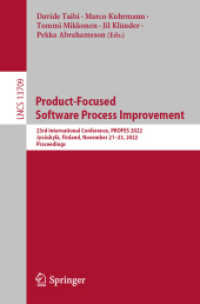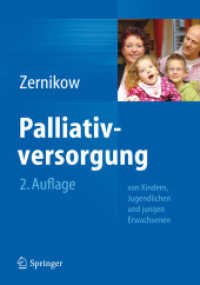Full Description
This book presents key methodologies, tools and databases for biochemistry, microbiology and molecular biology in simple and straightforward language. Covering all aspects related to experimental principles and procedures, the protocols included here are brief and clearly defined, and include essential precautions to be taken while conducting experiments. The book is divided into two major sections: one on constructing, working with, and standard operating procedures for laboratory instruments; and one on practical procedures used in molecular biology, microbiology and biochemical analysis experiments, which are described in full.
Each chapter describes both the basic theory and relevant practical details for a given experiment, and helps readers recognize both the experiment's potential and limitations. Intended as an intensive introduction to the various tools used in molecular biology, the book covers all basic methods and equipment, including cloning, PCR, spectrophotometers, ELISA readers, sonicators, etc. As such, it offers a valuable asset for final year undergraduate (especially project) students, graduate research students, research scientists and technicians who wish to understand and employ new techniques in the field of biotechnology.
Contents
Chapter 1. BOD (Biochemical oxygen demand or biological oxygen demand) Incubator.- Chapter 2. Laminar Air Flow/ Biosafety Cabinets.- Chapter 3. Aseptic Hood.- Chapter 4. Autoclave.- Chapter 5. Hot Air Oven.- Chapter 6. Deep Freezer (-20 0C) (Low Temperature Cabinet).- Chapter 7. Refrigerator.- Chapter 8. Compound Microscope.- Chapter 9. Digital Colony Counter.- Chapter 10. Digital Turbidity Meter.- Chapter 11. Digital Nephel Ometer.- Chapter 12. Digital Colorimeter.- Chapter 13. Digital UV / Visible Spectrophotometer.- Chapter 14. Polymerase Chain Reaction.- Chapter 15. ELISA Reader.- Chapter 16. Sonicator.- Chapter 17. Enzyme Assay: Qualitative and Quantitative (Protease, Amylase, Penicillinase, Pectinolytic Enzyme, Chitinase, Keratinase).- Chapter 18. Antimicrobial Sensitivity Assay.- Chapter 19. Extraction of DNA from plant cells.- Chapter 20. Extraction of DNAfrom Animal cells.- Chapter 21. Extraction of DNA and RNA from microorganism.- Chapter 22. Estimation of DNA by Diphenylamine Reaction.- Chapter 23. Estimation of RNA using Orcinol Method.- Chapter 24. Determination of Melting Temperature of DNA.- Chapter 25. Quantitative Estimation of DNA AND RNA.- Chapter 26. Purification and Bioassay of Interleukin 1 and 2 (IL 1 AND IL 2).- Chapter 27. Object: Quantitative Determination of TNF Alpha and Interleukin 6 in the given sample.- Chapter 28. Sterilization of Glassware, Preparation of Media and its Sterilization.- Chapter 29. Sub Culturing of Bacteria, Fungi and Actinomycetes.- Chapter 30. Preservation of Microorganisms: Stabs, Slants, Lyophilization, Cryopreservation.- Chapter 31. Staining Methods: Simple, Negative, Gram Staining, Acid-Fast Staining, Cell Wall, Capsule, Flagella, Nuclear material, Cytoplasm, Filamentous Fungi, Mycoplasma.- Chapter 32. Isolation of Coprophilous Fungi (By Moist Chamber Method).- Chapter 33. Isolation of Microorganisms from air.- Chapter 34. Motility Testing: Hanging Drop Method and Stab.- Chapter 35. Sterility Testing of Pharmaceuticals.- Chapter 36. Physical, Chemical and Bacteriological Analysis of Water. (a) Physical and Chemical Analysis of Water (b) Bacteriological Analysis of Water.- Chapter 37. To Perform Biochemical Identification of Microorganism: Imvic, Oxidative Fermentation, Carbohydrate Source Utilization.- Chapter 38. To Perform Identification of Microorganism by Urease Test.- Chapter 39. Immobilization of Enzymes and Microorganisms.- Chapter 40. Qualitative Systematic Analysis of Carbohydrates (Glucose, Fructose, Lactose, Maltose, Sucrose and Starch).- Chapter 41. Protein Analysis in Food.- Chapter 42. Identification Tests for Proteins (Casein and Albumin).- Chapter 43. Quantitative Analysis of Reducing Sugars by 3, 5-Dinitrosalicylic Acid (Dnsa Method).- Chapter 44. Quantitative Analysis of Proteins by Various Methods Including Biuret.- Chapter 45. Qualitative Anaylsis of Urine for Abnormal Constituents.- Chapter 46. Determination of Blood Creatinine.- Chapter 47. Determination of Blood Sugar.- Chapter 48. To Perform Oral Glucose Tolerance Test.- Chapter 49. Determination of Serum Total Cholesterol.- Chapter 50. Preparation of Buffer Solution and Measurement of PH.- Chapter 51. Study of Enzymatic Hydrolysis of Starch.- Chapter 52. Determination of Salivary Amylase Activity.- Chapter 53. Study the Effect of Temperature on Salivary Amylase Activity.- Chapter 54. Study the Effect of Substrate Concentration on Salivary Amylase Activity.- Chapter 55. Analysis of Butter.- Chapter 56. Analysis of Milk.- Chapter 57. Tlc of Carbohydrates.- Chapter 58. Tlc of Amino Acid.- Chapter 59. Paper Chromatography of Amino Acid.- Chapter 60. Paper Chromatography of Carbohydrates.- Chapter 61. Fat Characterization.- Chapter 62. Analysis of Bread.







